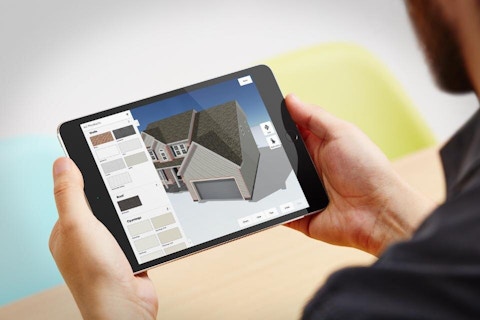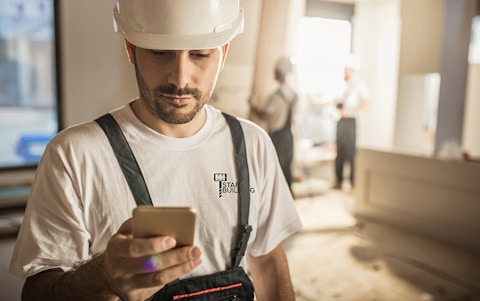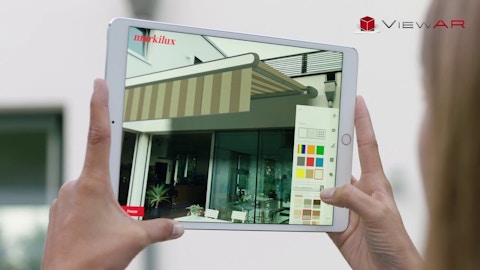More About This Show
The Smarter Building Materials Marketing podcast helps industry professionals find better ways to grow leads, sales and outperform the competition. It’s designed to give insight on how to create a results-driven digital marketing strategy for companies of any size.
In this episode, Zach and talk to Tim Sandlund, Digital Marketing Manager at Derby Building Products and Founder of StartBuildingSomething.com, about his experience launching AR and VR tools in building materials, where he thinks the best channels for success are and how to measure that success to determine what’s working.
A Passion for Technology

Tim’s worn a lot of hats over the course of his career. With a background in marketing, he’s worked for manufacturers like TimberTech and AZEK, and also on the agency side of marketing and branding. Most of his work these days is around web visualization tools, but he’s also got expertise in using AR and VR apps.
At AZEK and TimberTech, Tim was part of the team that launched the first augmented reality app in the building products industry. For an industry that is not always very tech-savvy, the AR app was a huge step forward, and it sparked a passion for new technology in Tim: “Seeing the results of that, seeing it grow in different ways. This is the future, and that’s what I get really excited about.”
Tim’s most recent endeavor is the website StartBuildingSomething.com, which explores technology and innovation in the building products industry. “Right now it's kind of highly focused on AR and VR, but it goes on from there with visualization, digital marketing, that type thing.”
The AR and VR landscape has changed pretty significantly over the course of Tim’s career. The AZEK AR app was launched back in 2012, four years before Pokemon GO! would make AR a common dinnertime discussion topic.
“We were trying to solve this problem of how do you put a deck on the back of the house. How do people visualize the deck? Now you can do that in 2D within online visualizers. But this opportunity with augmented reality allowed us to literally put a deck with railing on the back of someone's house and then be able to see what their view would look like.”
But Does It Work?

Tim admits that the adoption of AR and VR technology has been slower than he might have expected, but that nearly anyone who tries it sees the benefits immediately. Not only do homeowners have an opportunity to see what the finished project will look like in the actual environment of their home, but it creates a powerful tool for designers and contractors, too.
“It was a solution for our contractors and our dealers and our channel partners that would help grow their business. When I traveled the country and did trainings, they saw the value very quickly.”
"When I traveled the country and did trainings, they saw the value very quickly."
Each year, when Tim attends events and tradeshows like IBS, he sees more and more vendors and manufacturers using AR and VR to draw customers in. But Zach wants to know if AR and VR are actually working as sales and marketing tools, or if they’re just a fun gimmick to entertain people as they walk the tradeshow floor:
“What I want to know as a marketer is what kind of data do you have that says, ‘Hey, this helped us sell X amount of more or this helped us accomplish X, Y and Z. Or is it just something that in your gut, in your feedback from people in the field using it, saying they found that helped? Or do you have actual concrete data that said, we saw this kind of return?’
Tim says he has both. Certainly, when he helped launch the AZEK app, the interest and demand for training from channel partners was huge.
“We had reps calling all the time saying, ‘Tell me more about this. Train me. Can you train this person? Can you send me a marker?’ There was so much interest in it. I traveled the Northeast region and trained contractors and dealers. Initially, their reps said, ‘Oh we don't really want to do this. There's a lot of work.’ And when I left they were like, ‘Can you do this every quarter?’”
And while enthusiasm is great, it doesn’t materially keep the lights on, but Tim has data to back up his claims, too. He refers to a Lowe’s project he worked on where they set up VR booths in twenty locations, and the stores reported a 20 to 30% increase in kitchen and bath sales compared to other locations in their region.
One Reality Does Not Fit All

So the data supports that adopting AR and VR into sales and marketing strategies does lead to more sales, but that doesn’t mean we should all be building AR apps for our products right now.
Zach says, “If I'm a manufacturer and I'm considering dipping my toe into this space, help me think through the process of knowing which one of AR or VR or the different options is the right one for me?”
Tim sees AR as being better suited for manufacturers, and VR for homebuilders. “Anything that's large enough to where you want to be fully immersed within that location, that's where you want virtual reality. You want to walk around, you want to feel your space and that's why it's really taking off more in the home building industry.”
For manufacturers, he sees AR as being a great way to showcase products and help communicate more efficiently down the channel. “My recommendation, and this is going back to when we did this at AZEK and TimberTech, we looked at it and said, ‘Okay, what are the problems that AR reality could potentially solve? Let's look at what our goal is and then we'll have a three to five-year plan of how to build that up.’"
And while he’s passionate about the problems both technologies can solve and the conversations it fosters in the industry and with customers, Tim knows it’s not the only solution.
“AR/VR is not the end all be all. Web is here to stay. Web is not going anywhere. I love web visualization, and I think the future will be a mixture of web visualization along with augmented reality and virtual reality type plugins. Right? They'll all play together because they all serve a different purpose and add value in different ways.”
Even the Future Has a Future

Both Tim and Zach admit that while AR and VR technology have come a long way, there are still gaps in what it can do that discourage wider adoption. Tim’s early experience with deck builders was great, but the app was limited to predetermined square and rectangular shapes.
“The goal was how do you design a fully customized deck and then put it on the back of your house using augmented reality. Still not there yet.” Without the ability to customize as manufacturers and builders want to, there will always be limits to adoption.
"Whatever you're doing needs to be intuitive."
Tim says, “It's gotta be simple, right? It's gotta be quick. So whatever you're doing needs to be intuitive and allow a contractor or a dealer to catch onto it very quickly. It also has to add value. If you can add value very quickly by putting a deck on the back of the house, for example, all of a sudden they're going to start using that in their daily format. ”
He’s also seeing wider applications of AR for interior products too, especially for indoor and outdoor furniture. Companies like Ikea, Amazon and Wayfair are all looking AR options for furniture. “You can showcase that in five minutes, show them what it's gonna look like. Here's the size, it's going to fit this part of your deck.”
If You Build It, Will They Come?

For manufacturers considering an AR app in their sales and marketing plans, don’t assume it will be an instant home run. Like any new feature, there will be an education period where reps have to educate partners and customers before real buy-in can occur.
Tim says, “Four years ago, this was crazy new technology. This is still very new technology. So this idea that if you launch this and you start telling people, ‘Hey, we've got this AR app,’ you're still going to have a vast majority of people being like, ‘What is that? I don't know what that is.’”
But that doesn’t mean it’s not worth pursuing. “Put something out there, test it, see what the feedback is, and then iterate off that. And as the technology gets better, your application is going to get better and better.”
And, like all new products and sales tactics, listen to customers and work hard to give them what they want. “My contractors, they really want to be able to measure. Yeah, they can visualize. But what about measuring? Can we just tie that all together? Great. Let's add a measuring application, and tie it into where it gives them their square footage.”
Introducing any new technology should be viewed as an iterative process. Very rarely do you get something that does it all upfront, and nor should it. By listening to customers and analyzing metrics, you’ll gain a great sense of what people are really looking for and what they want and need your app to do.
Like everything in marketing, data is critical in decision making, but so often, app owners and developers rely on metrics like the number of downloads to measure success. And while that figure may be valuable, it doesn’t give any real insight into usage and sales conversions.
Tim says, “I think what truly is important is getting out in the field and understanding where's the value happening from the dealer or the contractor and the homeowner and in manufacturing.”
He recommends really spending time with contractors to understand how they’re using the app and where its value lies. “What would make this better? How would this make your life easier? How do you see yourself using this technology within your day to day business?”
Start Now

Tim’s parting words of advice are that there’s no time like the present. “If you're a manufacturer and you don't have any type of visualization, you need to do that ASAP. That is becoming a marketing 101. Homeowners are expecting it. Contractors are using it, dealers are using it. It's becoming a part of the buying process.”
"Use the data, the analytics to make it better and figure out what's going to bring value to the end-user.”
Not only will features like this increase buyer engagement and meet their expectations for what a modern supplier offers, but it also gives manufacturers valuable insight into what people are looking at. “And I think that's for anything digital. Use the data, the analytics to make it better and figure out what's going to bring value to the end-user.”
In this day and age where everything is fast and convenient, buyers are increasingly expecting businesses in building materials to be the same. Tim wants manufacturers and builders to look for opportunities to go from a slower process where homeowners upload a picture of their home, to one where they can design a feature, and have it placed virtually on their home in minutes. He admits the technology isn’t there yet, but the future is getting closer all the time.
Got a Question?
Get in touch with Tim on LinkedIn.
If you have questions about how to enhance your sales and marketing with AR or VR technology, let us know! Shoot us an email at [email protected] with all of your questions.








